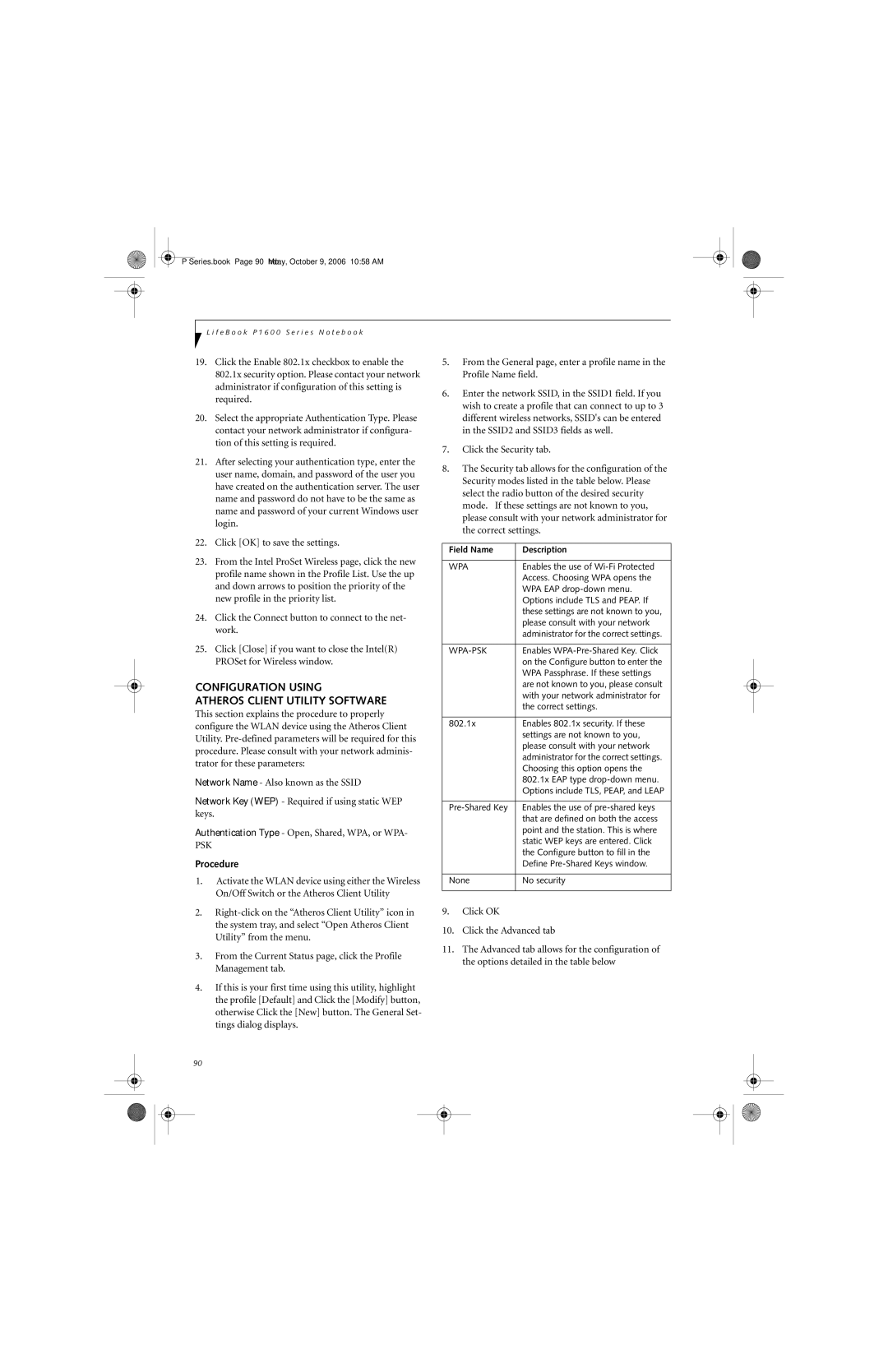
P Series.book Page 90 Monday, October 9, 2006 10:58 AM
L i f e B o o k P 1 6 0 0 S e r i e s N o t e b o o k
19.Click the Enable 802.1x checkbox to enable the 802.1x security option. Please contact your network administrator if configuration of this setting is required.
20.Select the appropriate Authentication Type. Please contact your network administrator if configura- tion of this setting is required.
21.After selecting your authentication type, enter the user name, domain, and password of the user you have created on the authentication server. The user name and password do not have to be the same as name and password of your current Windows user login.
22.Click [OK] to save the settings.
23.From the Intel ProSet Wireless page, click the new profile name shown in the Profile List. Use the up and down arrows to position the priority of the new profile in the priority list.
24.Click the Connect button to connect to the net- work.
25.Click [Close] if you want to close the Intel(R) PROSet for Wireless window.
CONFIGURATION USING
ATHEROS CLIENT UTILITY SOFTWARE
This section explains the procedure to properly configure the WLAN device using the Atheros Client Utility.
Network Name - Also known as the SSID
Network Key (WEP) - Required if using static WEP keys.
Authentication Type - Open, Shared, WPA, or WPA-
PSK
Procedure
1.Activate the WLAN device using either the Wireless On/Off Switch or the Atheros Client Utility
2.
3.From the Current Status page, click the Profile Management tab.
4.If this is your first time using this utility, highlight the profile [Default] and Click the [Modify] button, otherwise Click the [New] button. The General Set- tings dialog displays.
90
5.From the General page, enter a profile name in the Profile Name field.
6.Enter the network SSID, in the SSID1 field. If you wish to create a profile that can connect to up to 3 different wireless networks, SSID's can be entered in the SSID2 and SSID3 fields as well.
7.Click the Security tab.
8.The Security tab allows for the configuration of the Security modes listed in the table below. Please select the radio button of the desired security mode. If these settings are not known to you, please consult with your network administrator for the correct settings.
Field Name | Description |
|
|
WPA | Enables the use of |
| Access. Choosing WPA opens the |
| WPA EAP |
| Options include TLS and PEAP. If |
| these settings are not known to you, |
| please consult with your network |
| administrator for the correct settings. |
|
|
| Enables |
| on the Configure button to enter the |
| WPA Passphrase. If these settings |
| are not known to you, please consult |
| with your network administrator for |
| the correct settings. |
|
|
802.1x | Enables 802.1x security. If these |
| settings are not known to you, |
| please consult with your network |
| administrator for the correct settings. |
| Choosing this option opens the |
| 802.1x EAP type |
| Options include TLS, PEAP, and LEAP |
|
|
Enables the use of | |
| that are defined on both the access |
| point and the station. This is where |
| static WEP keys are entered. Click |
| the Configure button to fill in the |
| Define |
|
|
None | No security |
|
|
9.Click OK
10.Click the Advanced tab
11.The Advanced tab allows for the configuration of the options detailed in the table below
